BMO 6630: Business Research Methods - Dining Consumption Review
VerifiedAdded on 2022/09/14
|7
|1742
|46
Literature Review
AI Summary
This literature review examines four articles related to dining consumption in restaurants, focusing on commonalities and differences in research methodologies, limitations, and future research directions. The review covers studies on nutritional information, consumer preferences, brand relationships, and the impact of luxury restaurant environments on diners' emotions and loyalty. It identifies similarities in the objectives of understanding consumer behavior and attitudes but highlights differences in data collection methods, findings, and limitations. The review concludes by suggesting future research directions, such as exploring the impact of personal health information, conducting comparative studies across different restaurant types, and investigating the influence of culture and family dining on consumption patterns. Desklib provides access to similar solved assignments for students.
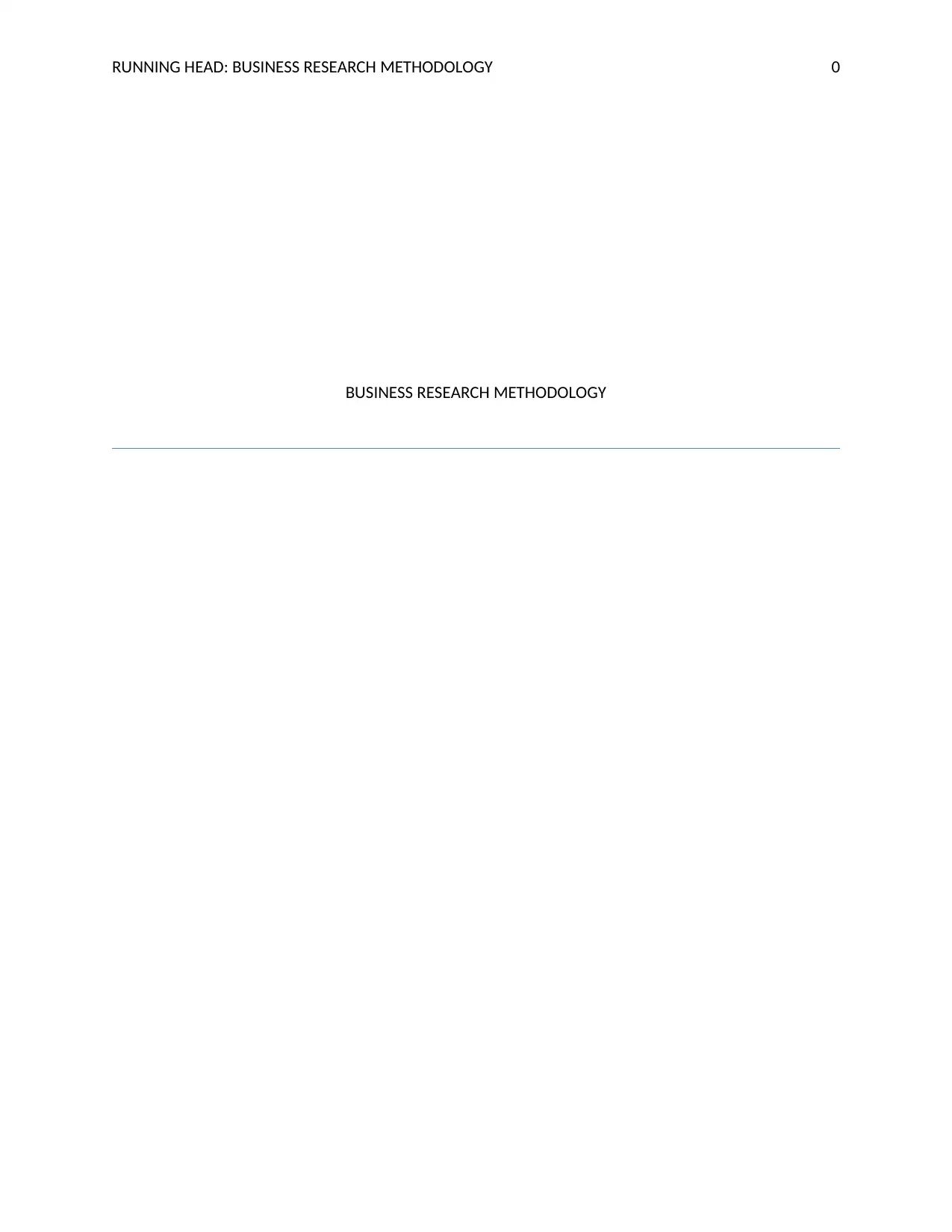
RUNNING HEAD: BUSINESS RESEARCH METHODOLOGY 0
BUSINESS RESEARCH METHODOLOGY
BUSINESS RESEARCH METHODOLOGY
Paraphrase This Document
Need a fresh take? Get an instant paraphrase of this document with our AI Paraphraser
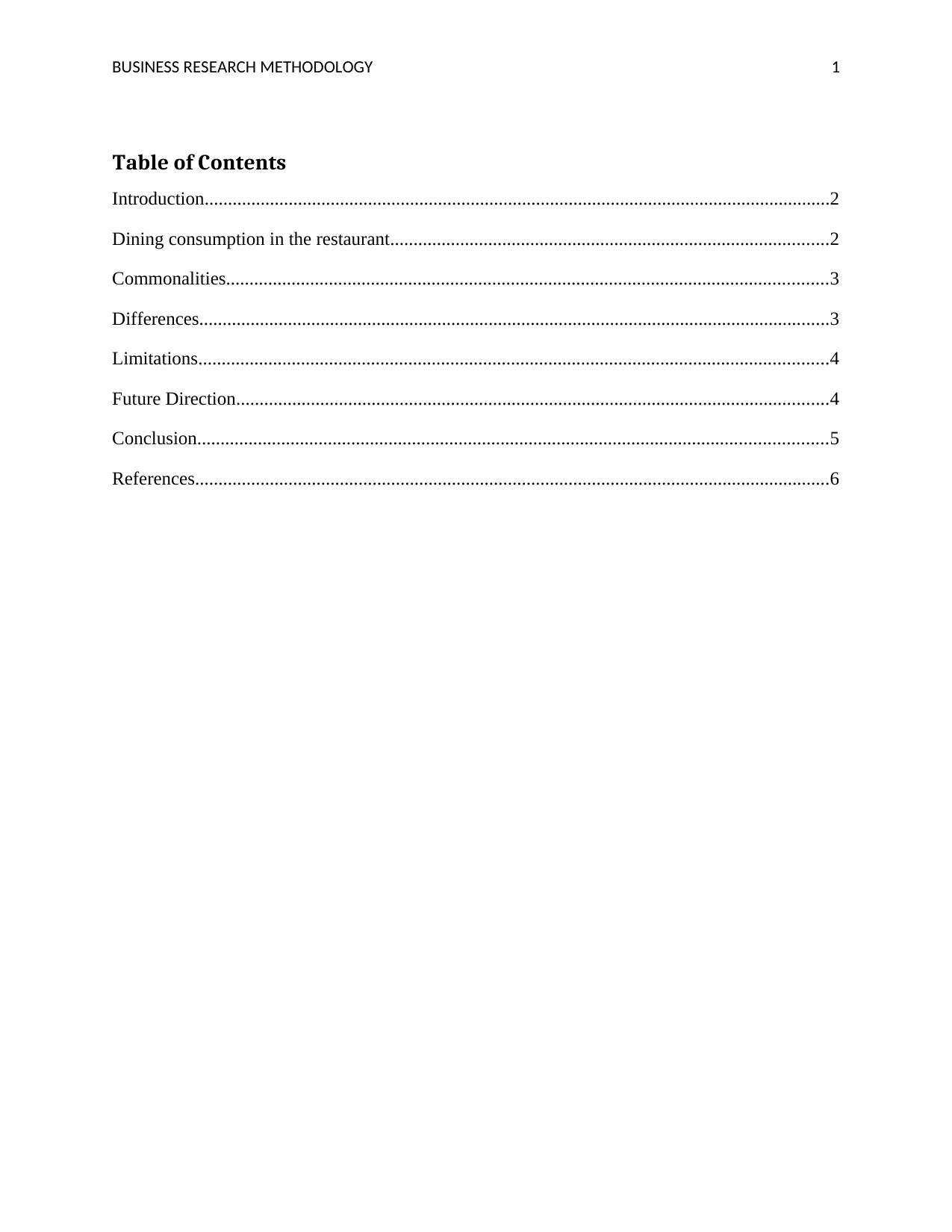
BUSINESS RESEARCH METHODOLOGY 1
Table of Contents
Introduction......................................................................................................................................2
Dining consumption in the restaurant..............................................................................................2
Commonalities.................................................................................................................................3
Differences.......................................................................................................................................3
Limitations.......................................................................................................................................4
Future Direction...............................................................................................................................4
Conclusion.......................................................................................................................................5
References........................................................................................................................................6
Table of Contents
Introduction......................................................................................................................................2
Dining consumption in the restaurant..............................................................................................2
Commonalities.................................................................................................................................3
Differences.......................................................................................................................................3
Limitations.......................................................................................................................................4
Future Direction...............................................................................................................................4
Conclusion.......................................................................................................................................5
References........................................................................................................................................6
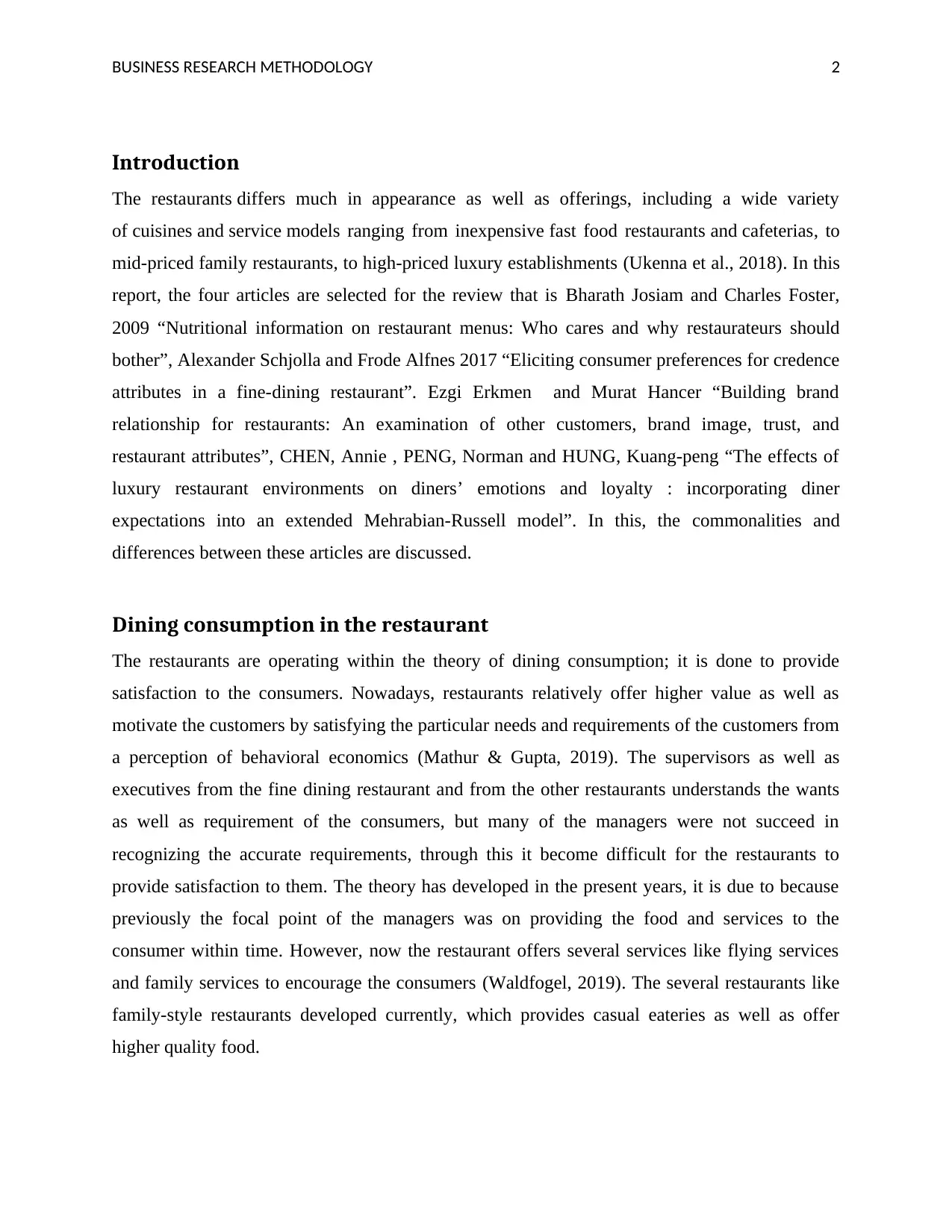
BUSINESS RESEARCH METHODOLOGY 2
Introduction
The restaurants differs much in appearance as well as offerings, including a wide variety
of cuisines and service models ranging from inexpensive fast food restaurants and cafeterias, to
mid-priced family restaurants, to high-priced luxury establishments (Ukenna et al., 2018). In this
report, the four articles are selected for the review that is Bharath Josiam and Charles Foster,
2009 “Nutritional information on restaurant menus: Who cares and why restaurateurs should
bother”, Alexander Schjolla and Frode Alfnes 2017 “Eliciting consumer preferences for credence
attributes in a fine-dining restaurant”. Ezgi Erkmen and Murat Hancer “Building brand
relationship for restaurants: An examination of other customers, brand image, trust, and
restaurant attributes”, CHEN, Annie , PENG, Norman and HUNG, Kuang-peng “The effects of
luxury restaurant environments on diners’ emotions and loyalty : incorporating diner
expectations into an extended Mehrabian-Russell model”. In this, the commonalities and
differences between these articles are discussed.
Dining consumption in the restaurant
The restaurants are operating within the theory of dining consumption; it is done to provide
satisfaction to the consumers. Nowadays, restaurants relatively offer higher value as well as
motivate the customers by satisfying the particular needs and requirements of the customers from
a perception of behavioral economics (Mathur & Gupta, 2019). The supervisors as well as
executives from the fine dining restaurant and from the other restaurants understands the wants
as well as requirement of the consumers, but many of the managers were not succeed in
recognizing the accurate requirements, through this it become difficult for the restaurants to
provide satisfaction to them. The theory has developed in the present years, it is due to because
previously the focal point of the managers was on providing the food and services to the
consumer within time. However, now the restaurant offers several services like flying services
and family services to encourage the consumers (Waldfogel, 2019). The several restaurants like
family-style restaurants developed currently, which provides casual eateries as well as offer
higher quality food.
Introduction
The restaurants differs much in appearance as well as offerings, including a wide variety
of cuisines and service models ranging from inexpensive fast food restaurants and cafeterias, to
mid-priced family restaurants, to high-priced luxury establishments (Ukenna et al., 2018). In this
report, the four articles are selected for the review that is Bharath Josiam and Charles Foster,
2009 “Nutritional information on restaurant menus: Who cares and why restaurateurs should
bother”, Alexander Schjolla and Frode Alfnes 2017 “Eliciting consumer preferences for credence
attributes in a fine-dining restaurant”. Ezgi Erkmen and Murat Hancer “Building brand
relationship for restaurants: An examination of other customers, brand image, trust, and
restaurant attributes”, CHEN, Annie , PENG, Norman and HUNG, Kuang-peng “The effects of
luxury restaurant environments on diners’ emotions and loyalty : incorporating diner
expectations into an extended Mehrabian-Russell model”. In this, the commonalities and
differences between these articles are discussed.
Dining consumption in the restaurant
The restaurants are operating within the theory of dining consumption; it is done to provide
satisfaction to the consumers. Nowadays, restaurants relatively offer higher value as well as
motivate the customers by satisfying the particular needs and requirements of the customers from
a perception of behavioral economics (Mathur & Gupta, 2019). The supervisors as well as
executives from the fine dining restaurant and from the other restaurants understands the wants
as well as requirement of the consumers, but many of the managers were not succeed in
recognizing the accurate requirements, through this it become difficult for the restaurants to
provide satisfaction to them. The theory has developed in the present years, it is due to because
previously the focal point of the managers was on providing the food and services to the
consumer within time. However, now the restaurant offers several services like flying services
and family services to encourage the consumers (Waldfogel, 2019). The several restaurants like
family-style restaurants developed currently, which provides casual eateries as well as offer
higher quality food.
⊘ This is a preview!⊘
Do you want full access?
Subscribe today to unlock all pages.

Trusted by 1+ million students worldwide

BUSINESS RESEARCH METHODOLOGY 3
Commonalities
The objective of the study is common that is Josiam et al aim of the study is to determine the
needs and wants of the customers as well as their behavior and attitudes to the nutritional
information on the list of the menus in the restaurants which provide full-service (Josiam &
Foster, 2009). The one of the objective for conducting the study, by Schjolla et al is to examine
the behavior of the consumer regarding the information on the menu description in a Norwegian
restaurant, which provides full-services to the customers. Erkmen et al aim of the study is to
examine the role as well as behavior of other customers. The study is conducted with the
conceptual model to understand the attitudes of the customers as well as their preferences of the
brand for the fine dining restaurants (Erkmen & Hancer, 2019). The objective of Chen et al is to
know the diners consumption behavior of the customer in the luxuries restaurants by integrating
the expectations of the diner into a personalized Mehrabian–Russell model. In these articles the
similarities is that these study is conduced to know the attitudes and behaviors of the customers.
Differences
The study also has various differences, which is differences in using the methods for collecting
the data, limitations, findings etc. Josiam et al used the questionnaire method for collecting the
data from the customers who all consume the food in restaurants, which provides full- service.
The survey was also taken from the universities in USA. In the other study conducted by
Schjolla et al in the fine-dining restaurant, it is done with the experiment of menu labeling in the
normal hours of opening throughout the two weeks (Schjøll & Alfnes, 2017). The menu tagging
experiment is done in the restaurants by changing the description of the menu continuously and
then the results from this alteration are examined (Du et al., 2019). Erkmen et al used the
quantitative research method for conducting the study by using the model of structural equation;
this is done to understand the character of the customers along with the characteristics of other
restaurants. The data collection is done from the questionnaire and the survey was done from the
consumers of fine-dining restaurants (Erkmen & Hancer, 2019). Chen et al collected the data by
using both the approaches that is quantitative as well as qualitative. The qualitative method is
used by preparing the questions for the costumers who all dined in the luxury restaurants.
Commonalities
The objective of the study is common that is Josiam et al aim of the study is to determine the
needs and wants of the customers as well as their behavior and attitudes to the nutritional
information on the list of the menus in the restaurants which provide full-service (Josiam &
Foster, 2009). The one of the objective for conducting the study, by Schjolla et al is to examine
the behavior of the consumer regarding the information on the menu description in a Norwegian
restaurant, which provides full-services to the customers. Erkmen et al aim of the study is to
examine the role as well as behavior of other customers. The study is conducted with the
conceptual model to understand the attitudes of the customers as well as their preferences of the
brand for the fine dining restaurants (Erkmen & Hancer, 2019). The objective of Chen et al is to
know the diners consumption behavior of the customer in the luxuries restaurants by integrating
the expectations of the diner into a personalized Mehrabian–Russell model. In these articles the
similarities is that these study is conduced to know the attitudes and behaviors of the customers.
Differences
The study also has various differences, which is differences in using the methods for collecting
the data, limitations, findings etc. Josiam et al used the questionnaire method for collecting the
data from the customers who all consume the food in restaurants, which provides full- service.
The survey was also taken from the universities in USA. In the other study conducted by
Schjolla et al in the fine-dining restaurant, it is done with the experiment of menu labeling in the
normal hours of opening throughout the two weeks (Schjøll & Alfnes, 2017). The menu tagging
experiment is done in the restaurants by changing the description of the menu continuously and
then the results from this alteration are examined (Du et al., 2019). Erkmen et al used the
quantitative research method for conducting the study by using the model of structural equation;
this is done to understand the character of the customers along with the characteristics of other
restaurants. The data collection is done from the questionnaire and the survey was done from the
consumers of fine-dining restaurants (Erkmen & Hancer, 2019). Chen et al collected the data by
using both the approaches that is quantitative as well as qualitative. The qualitative method is
used by preparing the questions for the costumers who all dined in the luxury restaurants.
Paraphrase This Document
Need a fresh take? Get an instant paraphrase of this document with our AI Paraphraser
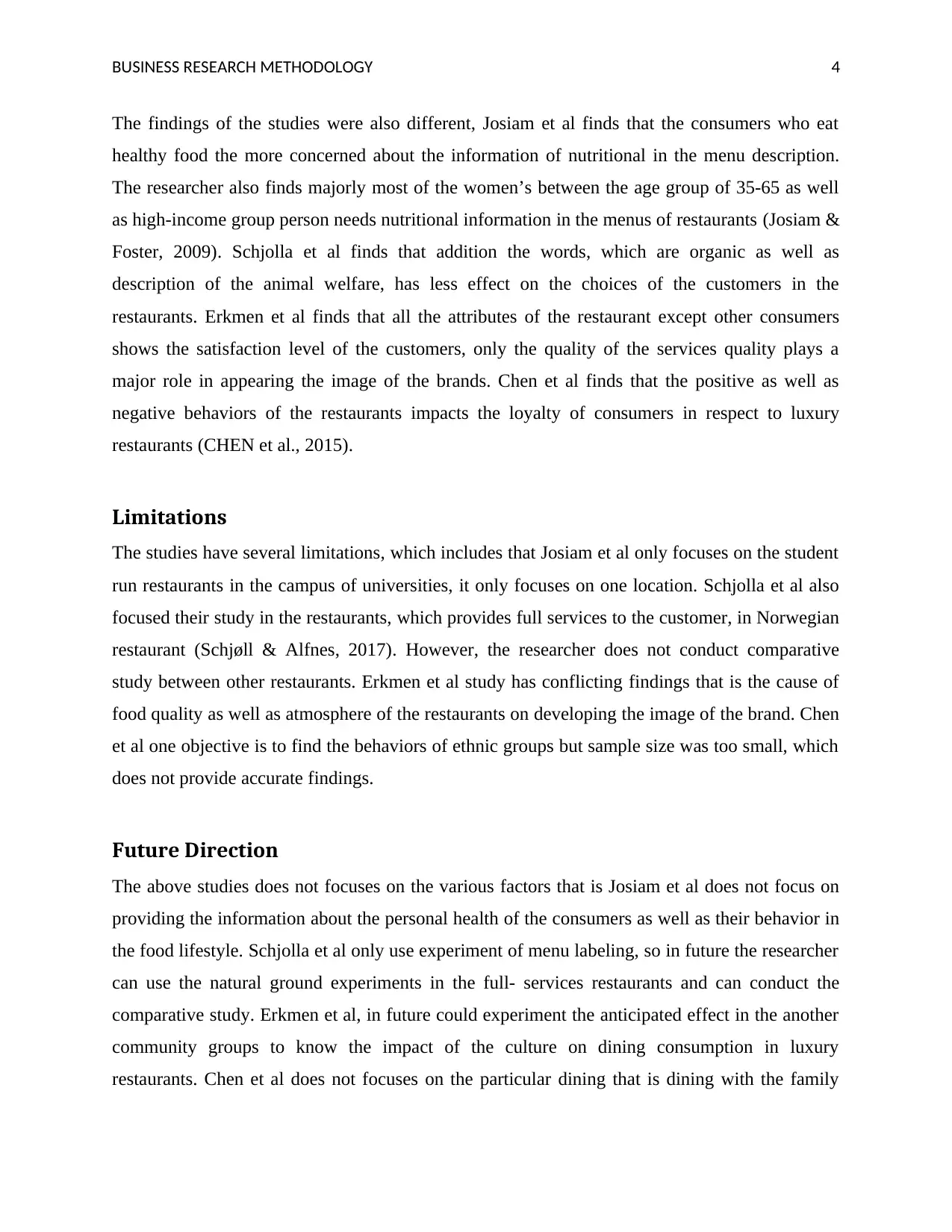
BUSINESS RESEARCH METHODOLOGY 4
The findings of the studies were also different, Josiam et al finds that the consumers who eat
healthy food the more concerned about the information of nutritional in the menu description.
The researcher also finds majorly most of the women’s between the age group of 35-65 as well
as high-income group person needs nutritional information in the menus of restaurants (Josiam &
Foster, 2009). Schjolla et al finds that addition the words, which are organic as well as
description of the animal welfare, has less effect on the choices of the customers in the
restaurants. Erkmen et al finds that all the attributes of the restaurant except other consumers
shows the satisfaction level of the customers, only the quality of the services quality plays a
major role in appearing the image of the brands. Chen et al finds that the positive as well as
negative behaviors of the restaurants impacts the loyalty of consumers in respect to luxury
restaurants (CHEN et al., 2015).
Limitations
The studies have several limitations, which includes that Josiam et al only focuses on the student
run restaurants in the campus of universities, it only focuses on one location. Schjolla et al also
focused their study in the restaurants, which provides full services to the customer, in Norwegian
restaurant (Schjøll & Alfnes, 2017). However, the researcher does not conduct comparative
study between other restaurants. Erkmen et al study has conflicting findings that is the cause of
food quality as well as atmosphere of the restaurants on developing the image of the brand. Chen
et al one objective is to find the behaviors of ethnic groups but sample size was too small, which
does not provide accurate findings.
Future Direction
The above studies does not focuses on the various factors that is Josiam et al does not focus on
providing the information about the personal health of the consumers as well as their behavior in
the food lifestyle. Schjolla et al only use experiment of menu labeling, so in future the researcher
can use the natural ground experiments in the full- services restaurants and can conduct the
comparative study. Erkmen et al, in future could experiment the anticipated effect in the another
community groups to know the impact of the culture on dining consumption in luxury
restaurants. Chen et al does not focuses on the particular dining that is dining with the family
The findings of the studies were also different, Josiam et al finds that the consumers who eat
healthy food the more concerned about the information of nutritional in the menu description.
The researcher also finds majorly most of the women’s between the age group of 35-65 as well
as high-income group person needs nutritional information in the menus of restaurants (Josiam &
Foster, 2009). Schjolla et al finds that addition the words, which are organic as well as
description of the animal welfare, has less effect on the choices of the customers in the
restaurants. Erkmen et al finds that all the attributes of the restaurant except other consumers
shows the satisfaction level of the customers, only the quality of the services quality plays a
major role in appearing the image of the brands. Chen et al finds that the positive as well as
negative behaviors of the restaurants impacts the loyalty of consumers in respect to luxury
restaurants (CHEN et al., 2015).
Limitations
The studies have several limitations, which includes that Josiam et al only focuses on the student
run restaurants in the campus of universities, it only focuses on one location. Schjolla et al also
focused their study in the restaurants, which provides full services to the customer, in Norwegian
restaurant (Schjøll & Alfnes, 2017). However, the researcher does not conduct comparative
study between other restaurants. Erkmen et al study has conflicting findings that is the cause of
food quality as well as atmosphere of the restaurants on developing the image of the brand. Chen
et al one objective is to find the behaviors of ethnic groups but sample size was too small, which
does not provide accurate findings.
Future Direction
The above studies does not focuses on the various factors that is Josiam et al does not focus on
providing the information about the personal health of the consumers as well as their behavior in
the food lifestyle. Schjolla et al only use experiment of menu labeling, so in future the researcher
can use the natural ground experiments in the full- services restaurants and can conduct the
comparative study. Erkmen et al, in future could experiment the anticipated effect in the another
community groups to know the impact of the culture on dining consumption in luxury
restaurants. Chen et al does not focuses on the particular dining that is dining with the family
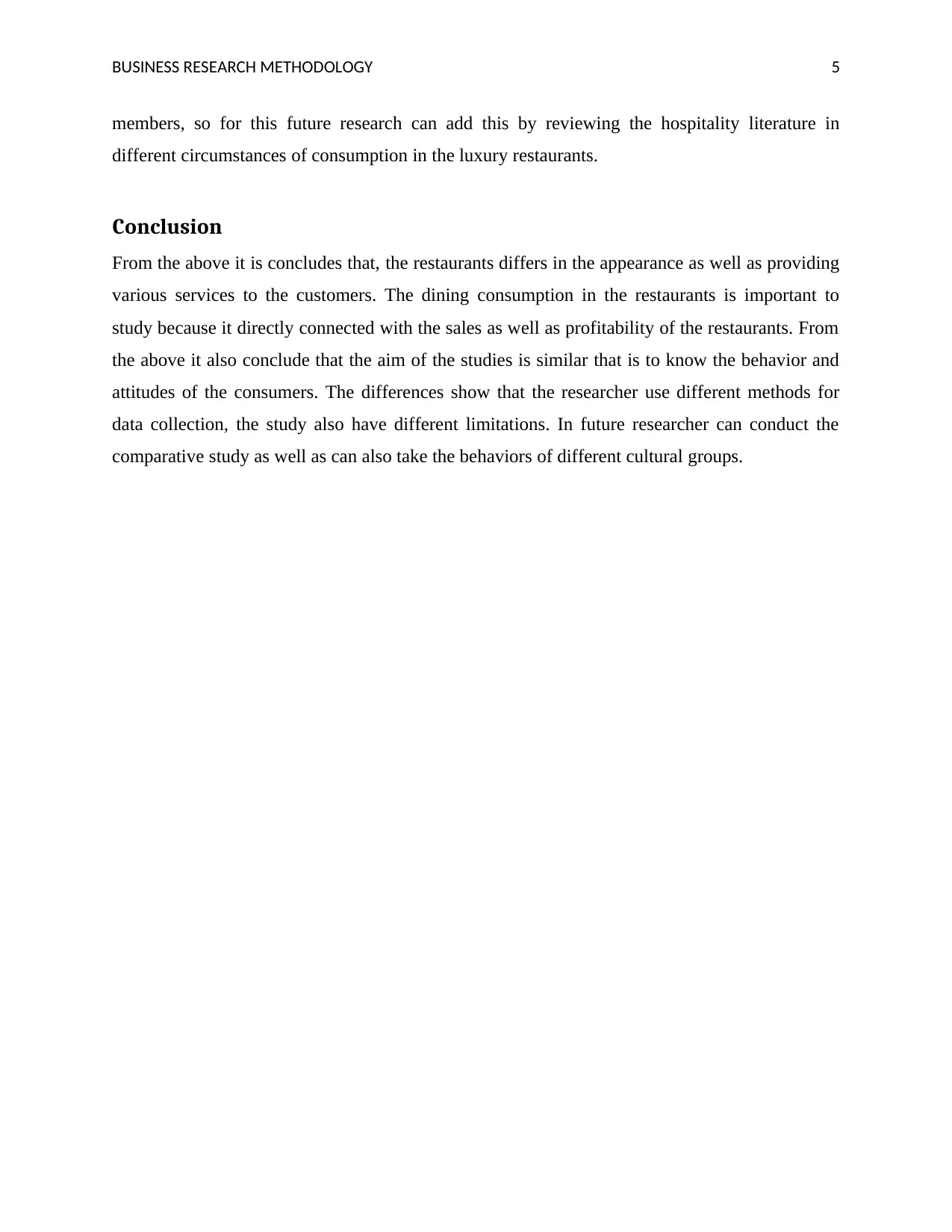
BUSINESS RESEARCH METHODOLOGY 5
members, so for this future research can add this by reviewing the hospitality literature in
different circumstances of consumption in the luxury restaurants.
Conclusion
From the above it is concludes that, the restaurants differs in the appearance as well as providing
various services to the customers. The dining consumption in the restaurants is important to
study because it directly connected with the sales as well as profitability of the restaurants. From
the above it also conclude that the aim of the studies is similar that is to know the behavior and
attitudes of the consumers. The differences show that the researcher use different methods for
data collection, the study also have different limitations. In future researcher can conduct the
comparative study as well as can also take the behaviors of different cultural groups.
members, so for this future research can add this by reviewing the hospitality literature in
different circumstances of consumption in the luxury restaurants.
Conclusion
From the above it is concludes that, the restaurants differs in the appearance as well as providing
various services to the customers. The dining consumption in the restaurants is important to
study because it directly connected with the sales as well as profitability of the restaurants. From
the above it also conclude that the aim of the studies is similar that is to know the behavior and
attitudes of the consumers. The differences show that the researcher use different methods for
data collection, the study also have different limitations. In future researcher can conduct the
comparative study as well as can also take the behaviors of different cultural groups.
⊘ This is a preview!⊘
Do you want full access?
Subscribe today to unlock all pages.

Trusted by 1+ million students worldwide

BUSINESS RESEARCH METHODOLOGY 6
References
CHEN, A., PENG, N. & HUNG, K.p., 2015. he effects of luxury restaurant environments on
diners’ emotions and loyalty: incorporating diner expectations into an extended Mehrabian-
Russell model. International Journal of Contemporary Hospitality Management, 27(2), pp.236-
60.
Du, D. et al., 2019. ElemCor: accurate data analysis and enrichment calculation for high-
resolution LC-MS stable isotope labeling experiments. BMC bioinformatics, 20(1), p.89.
Erkmen, E. & Hancer, M., 2019. Building brand relationship for restaurants: An examination of
other customers, brand image, trust, and restaurant attributes.. International Journal of
Contemporary Hospitality Management, 31(3), pp.1469-87.
Josiam, B. & Foster, C., 2009. Nutritional information on restaurant menus restaurant menus
bother. International Journal of Contemporary Hospitality Management, 21(7), pp.876-91.
Mathur, T. & Gupta, A., 2019. Impact of ‘Dining atmospherics’ and ‘Percived food-quality’on
customer re-patronage intention in fast-casual restaurants. Tourism and hospitality management,
25(1), pp.1-25.
Schjøll, A. & Alfnes, F., 2017. Eliciting consumer preferences for credence attributes in a fine-
dining restaurant. British Food Journal, 119(3), pp.575-86.
Ukenna, S.I., Ogbari, M.E., Adeola, A. & Nkamnebe, A.D., 2018. Applying the Extended
Theory of Planned Behaviour to Predict Sustainable Street Food Patronage: An Integrated
Conceptual Framework. Journal of Business, 2(1).
Waldfogel, J., 2019. Dining out as cultural trade. Journal of Cultural Economics, pp.1-30.
References
CHEN, A., PENG, N. & HUNG, K.p., 2015. he effects of luxury restaurant environments on
diners’ emotions and loyalty: incorporating diner expectations into an extended Mehrabian-
Russell model. International Journal of Contemporary Hospitality Management, 27(2), pp.236-
60.
Du, D. et al., 2019. ElemCor: accurate data analysis and enrichment calculation for high-
resolution LC-MS stable isotope labeling experiments. BMC bioinformatics, 20(1), p.89.
Erkmen, E. & Hancer, M., 2019. Building brand relationship for restaurants: An examination of
other customers, brand image, trust, and restaurant attributes.. International Journal of
Contemporary Hospitality Management, 31(3), pp.1469-87.
Josiam, B. & Foster, C., 2009. Nutritional information on restaurant menus restaurant menus
bother. International Journal of Contemporary Hospitality Management, 21(7), pp.876-91.
Mathur, T. & Gupta, A., 2019. Impact of ‘Dining atmospherics’ and ‘Percived food-quality’on
customer re-patronage intention in fast-casual restaurants. Tourism and hospitality management,
25(1), pp.1-25.
Schjøll, A. & Alfnes, F., 2017. Eliciting consumer preferences for credence attributes in a fine-
dining restaurant. British Food Journal, 119(3), pp.575-86.
Ukenna, S.I., Ogbari, M.E., Adeola, A. & Nkamnebe, A.D., 2018. Applying the Extended
Theory of Planned Behaviour to Predict Sustainable Street Food Patronage: An Integrated
Conceptual Framework. Journal of Business, 2(1).
Waldfogel, J., 2019. Dining out as cultural trade. Journal of Cultural Economics, pp.1-30.
1 out of 7
Related Documents
Your All-in-One AI-Powered Toolkit for Academic Success.
+13062052269
info@desklib.com
Available 24*7 on WhatsApp / Email
![[object Object]](/_next/static/media/star-bottom.7253800d.svg)
Unlock your academic potential
Copyright © 2020–2025 A2Z Services. All Rights Reserved. Developed and managed by ZUCOL.





